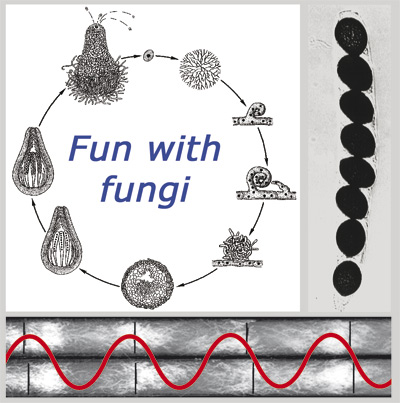Functional genomics of fungal morphogenesis |
 |
Functional genomics of fungal morphogenesis |
 |

Project group "Functional genomics of fungal morphogenesis" (principal investigator: Minou Nowrousian) at the Department of Molecular and Cellular Botany at the Ruhr-Universität Bochum.
Filamentous fungi grow in form of hyphae (elongated, branched cell filaments). They can aggregate to form complex structures, e.g. fruiting bodies in which spores are formed. We are interested in the genetic basis of these differentiation processes. To analyze how fruiting body formation is regulated at the molecular level, we use mutant strains that are blocked at different stages of development and compare gene expression in the mutants to that of the wild type using a combination of laser microdissection and RNA-seq, and quantitative real time PCR. Additionally, we compare gene expression in several fungal species to identify expression patterns that are evolutionary conserved (comparative functional genomics). Genes with similar regulation will help to define a core group of genes involved in fungal fruiting body development.
In a second project, we are studying the evolution of mating type genes in the Tremellomycetes, a group of basidiomycetes that contains many species that grow as yeasts (unicellular fungi). The ancestral state of basidiomycete mating type organisation in thought to be tetrapolar, i.e. each strain contains two non-linked (independently segregating) mating type loci. However, in a number of basidiomycetes, the two mating type loci became physically linked on the same chromosome. This arrangement is predicted to facilitate inbreeding, which might be an advantage if mating partners are hard to find, e.g. for pathogenic species in a host environment. We are currently focusing on the order Trichosporonales, where all strains analyzed so far contain physically linked mating type loci in an evolutionary conserved genomic arrangement.
More details about these projects can be found on the projects page or in several publications.
Breuer J, Ferreira DEA, Kramer M, Bollerman J, Nowrousian M (2024) Functional analysis of chromatin-associated proteins in Sordaria macrospora reveals similar roles for RTT109 and ASF1 in development and DNA damage response. G3 (Bethesda) 14: jkae019 Paper at G3 ![]()
Breuer J, Busche T, Kalinowski J, Nowrousian M (2024) Histone binding of ASF1 is required for fruiting body development but not for genome stability in the filamentous fungus Sordaria macrospora. mBio 15: e0289623 Paper at mBio ![]()
Guerreiro MA, Ahrendt S, Pangilinan J, Chen C, Yan M, Lipzen A, Barry K, Grigoriev IV, Begerow D, Nowrousian M (2022) Draft genome sequences of strains CBS6241 and CBS6242 of the basidiomycetous yeast Filobasidium floriforme. G3 (Bethesda) 12: jkab398, doi: 10.1093/g3journal/jkab398 Paper at G3 ![]()
Sun S, Coelho MA, Heitman J, Nowrousian M (2019) Convergent evolution of linked mating-type loci in basidiomycete fungi. PLoS Genet 15: e1008365 Paper at PLoS Genetics ![]()